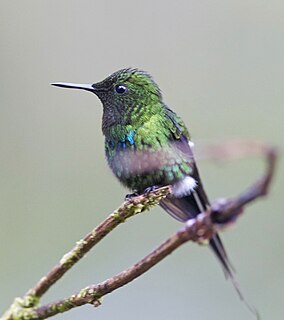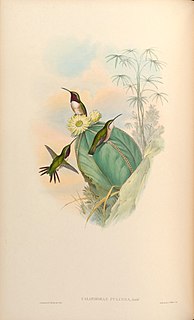
The long-billed starthroat is a species of hummingbird in the "mountain gems", tribe Lampornithini in subfamily Trochilinae. It is found in Mexico, Central America, Trinidad, and all but the four southermost countries of South America.

The blue-throated mountaingem, also known as the blue-throated mountain-gem or blue-throated hummingbird is a species of hummingbird in tribe Lampornithini of subfamily Trochilinae. It is found in Mexico and the United States.

The unspotted saw-whet owl is a small "typical owl" in subfamily Surniinae. It is found in Costa Rica, El Salvador, Guatemala, Mexico, and Panama.

Rivoli's hummingbird is a species of hummingbird in the "mountain gems", tribe Lampornithini in subfamily Trochilinae. It is found in El Salvador, Guatemala, Honduras, Mexico, Nicaragua, and the United States.

The purple-throated mountaingem is a species of hummingbird in tribe Lampornithini of subfamily Trochilinae. It is found in Costa Rica, Nicaragua, and Panama.

The rufous-tailed hummingbird is a medium-sized hummingbird in the "emeralds", tribe Trochilini of subfamily Trochilinae. It is found from east-central Mexico through Central America and Colombia into Ecuador and Venezuela.

The green thorntail is a small hummingbird in the "coquettes", tribe Lesbiini of subfamily Lesbiinae. It is found in Colombia, Costa Rica, Ecuador, and Panama.

The green-crowned brilliant is species of hummingbird in the "brilliants", tribe Heliantheini in subfamily Lesbiinae. It is found in Colombia, Costa Rica, Ecuador, and Panama. It is also known as the green-fronted brilliant.

The white-bellied emerald is a species of hummingbird in the "emeralds", tribe Trochilini of subfamily Trochilinae. It is found in Belize, Guatemala, Honduras, Mexico, and Nicaragua.

The cinnamon hummingbird is a species of hummingbird in the "emeralds", tribe Trochilini of subfamily Trochilinae. It is found from northwestern Mexico to Costa Rica.

The bumblebee hummingbird is a species of hummingbird in tribe Mellisugini of subfamily Trochilinae, the "bee hummingbirds". It is endemic to Mexico, but has occurred as a vagrant in the United States.

The beautiful sheartail or beautiful hummingbird is a species of hummingbird in tribe Mellisugini of subfamily Trochilinae, the "bee hummingbirds". It is endemic to Mexico.

The gorgeted woodstar is a species of hummingbird in tribe Mellisugini of subfamily Trochilinae, the "bee hummingbirds". It is found in Colombia, Ecuador, and Venezuela.

The green-throated carib is a species of hummingbird in the subfamily Polytminae. It is found in Puerto Rico and most of the Lesser Antilles.

The stripe-breasted starthroat is a species of hummingbird in the "mountain gems", tribe Lampornithini in subfamily Trochilinae. It is endemic to Brazil.

The amethyst-throated mountaingem, also called amethyst-throated mountain-gem or amethyst-throated hummingbird, is a species of hummingbird in tribe Lampornithini of subfamily Trochilinae. It is found in El Salvador, Guatemala, Honduras, and Mexico.

The bearded mountaineer or eastern mountaineer is a species of hummingbird in the "coquettes", tribe Lesbiini of subfamily Lesbiinae. It is endemic to Peru.

The great sapphirewing is a species of hummingbird in the "brilliants", tribe Heliantheini in subfamily Lesbiinae. It is found in Bolivia, Colombia, Ecuador, and Peru.

The purple-backed thornbill is a species of hummingbird in the "coquettes", tribe Lesbiini of subfamily Lesbiinae. It is found in Bolivia, Colombia, Ecuador, Peru, and Venezuela.

The sparkling-tailed woodstar, also known as the sparkling-tailed hummingbird, is a species of hummingbird in tribe Mellisugini of subfamily Trochilinae, the "bee hummingbirds". It is found in El Salvador, Guatemala, Honduras, Mexico, and Nicaragua.






















